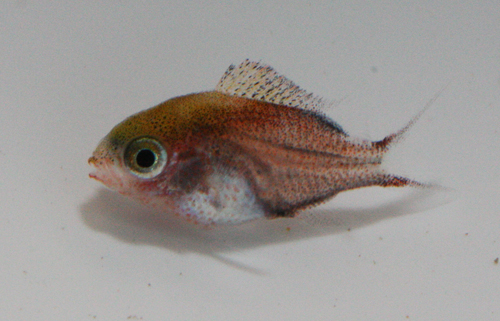
Earler today, Todd Gardner (the man to first breed Liopropoma basslets) announced a new breeding success at the Long Island Aquarium where two damselfish species were specifically mentioned. Neoglyphidodon melas, the Bowtie Damsel, was reared from larvae collected in the 20,000 gallon reef. A quick check of the MBI Database revealed a prior succes with N. melas. However, it’s the other species that has me all excited because it represents a likely species first, the Barrier Reef Chromis, Chromis nitida.

The breakthrough in question surrounds the first captive breeding and rearing of the Barrier Reef Chromis, Chromis nitida. Not only is this a very handsome and uncommon species in the trade, but its relative, the Green Chromis (C. viridis) is the single most highly collected marine fish in the trade based on recently released data. The Green Chromis spawns thousands of very small eggs and has larvae that hatch out as small prolarvae, not unlike the larvae of pelagic spawners like Dragonets or small-egg substrate spawners like the Harlequin Filefish.
The breeding and rearing protocol reported for the Green Chromis basically included the use of 2 copepod species and greenwater technique with Nannochloropsis, and yielded a success rate of 5%. What is interesting is that one of the copepods used to rear Green Chromis is a relative of one of the foods reportedly made available to the Barrier Reef Chromis.
Even more encouraging is Todd’s ongoing use of only cultured copepods in the rearing of the eggs and larvae collected from the 20,000 gallon reef tank. The three species Gardner mentions, Acartia tonsa, Pseudodiaptomus pelagicus (a relative of Ps. serricaudatus used to rear Chromis viridis), and Parvocalanus crassirostris, all have pre-existing known applications (Damsels, Mandarins, Angels and others). These copepods are all available through AlgaGen as we told you about last year. Amazing what a year can do.
What Todd is doing at the Long Island Aquarium should be considered mission-critical research to address a common aquaculture question – “What ELSE can I do with these materials”? In every sense, Todd’s work should be replicable by a landlocked, inland aquarist with the same basic raw materials. It is truly only a matter of time before we see things like hobbyist-reared angelfish. We here at Reef Builders applaud Gardner for continuing the ongoing legacy of “open source breeding”, where the open sharing of breeding successes and the methods used allows us all to advance together.
All Todd will tell us now is that there’s still more in the works…so stay tuned.



